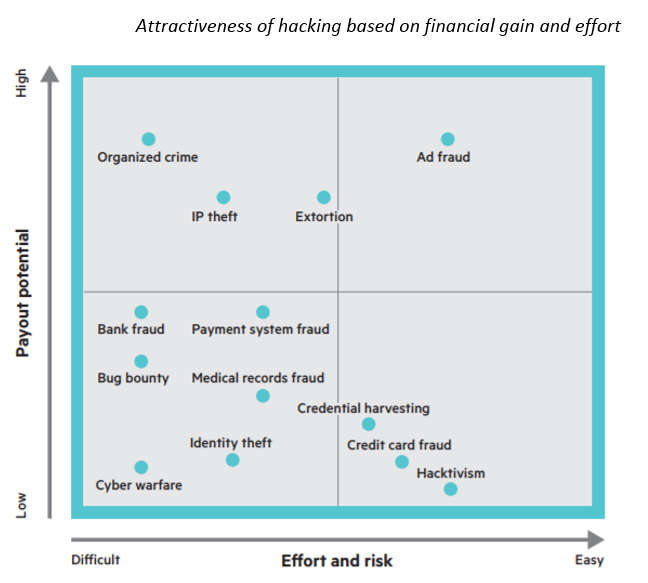Are You a Real Reader or is This Click Fraud?

Ad fraud is a huge problem for advertisers. Estimates vary, but a number of evaluations suggest that in 2017 around 10% of all money spent on digital ad buys is stolen.
HP Enterprise's report on "The Business of Hacking" says ad fraud is the kind of online criminal activity that has the lowest risk, is the easiest to do and has the highest payout [1]. No wonder it is attracting attention from criminals around the world.

White Ops, an organization focused on fighting online fraud, describes the situation this way: "Publishers paying handsomely for legitimate search traffic are competing against publishers paying much less for bot traffic, and the tools used by most marketers cannot tell the difference. Botty traffic vendors may defeat detection, but they never have a credible explanation for why they are able to deliver high volumes of visitors. When a publisher finds a source of traffic for $0.01 per visit that gets scored as viewable and 'high quality,' some might call that a gold mine. We would call it a gap in bot detection." [2]
Click fraud is a parasite that is feeding on every single company that advertises online. It has implications for ad tracking that should not be underestimated.
The necessity of effective ad tracking
There has always been a need for effective ad tracking. Ad fraud just underscores how big the disconnection is between paying to get ads presented to the right people, and knowing whether the ad communicated effectively.
But classic ad effectiveness tracking was designed for the old days, when people huddled around television sets and watched a handful of channels, or read one of a few newspapers and magazines. When advertising was about big ad buys focused on television or print ads aimed at the mass market, it made sense to track recall. And since the tracking was done largely by telephone interviews it was logical to track details about recall and how the ad was received and what impact it might have had, because most of the cost in a telephone interview was not in the length of the survey, but in finding a person willing to talk to you.
Times have changed. The world of mass media has long since passed away. Advertising has changed forever. But ad tracking has been slow in following suit. That's why we radically reinvented it.
Radically simple ad tracking for the digital age
We believe in streamlined research. Long questionnaires, giant banks of attributes, re-asking question that don't change, are relics of the past. No one has the time or patience to answer those surveys anymore—unless you're a bot [3] . Besides, our extensive research on research has shown that simple, easy to answer questions produce equivalent results to complicated scales and banks of attributes, and are more sensitive too [4].
Our approach is to have a laser focus on what is essential and to abandon all unnecessary questions. Forget unaided and aided message recall, brand image rating and price perceptions. You established all that when you pretested your creative. It's not going to change. Why re-ask it?
Skip unaided awareness. At best it will be a subset of aided awareness. At worst it will give you misleading information on mistaken identity. Regardless, it is a proxy for popularity and share of mind, and has very little to do with the advertising.
You can also forget repeat purchase, frequency of use, purchase intent, and price perceptions. People are terrible at self-reports of purchasing, and you already have much more sensitive sales data anyways.
We recommend showing the ad and asking aided awareness and then a single thumbs up or thumbs down like/dislike question. You know immediately if they know and like the ad. You identify ad wear-out when you see thumbs up decline, and thumbs down increase.
This radical simplicity enables you to test more executions of a campaign, as befits a more fragmented digital world. It also allows you to test an ad very inexpensively, as part of an omnibus survey. It likewise becomes very affordable to track more often, so that you can stay on top of ad wear out. Can you afford not to track your advertising, in a world of ad fraud?
Changing times demand changing approaches. Ad tracking is no exception. In fact, the issue of ad fraud makes it even more essential to be sure your advertising is effective. Be certain your money is well spent.
To learn more, check out our infographic Measuring Real Ad Impact.
- The Business of Hacking, Hewlett Packard Enterprise, 2017
- Bot Baseline 2016 – 2017, White Ops, 2017
- The problem of fake respondents is a significant one. It's another reason we invest heavily in recruiting known respondents into a community of engaged responders. To learn more about our extensive research into the problem of sample quality check out our article: Is This Water Safe? A Deep Dive into the Reliability and Representativeness of Survey Samples. It gives a great overview and directs you to a large collection of whitepapers we have written on different essential aspects of sample quality. To learn more our market communities, who are made up of deeply engaged, well-curated respondents who provide intelligence on an as-needed basis, click here.
- For evidence see, for example, our whitepaper Changing Times Demands Rethinking Old Approaches and the articles Idea Filter: Evidence of a Sensitive and Easy to Answer Approach to Idea and Concept Testing and Message Filter: Evidence of a Sensitive and Easy to Answer Approach to Message and Claims Testing.
Click the social buttons above or below to share this story with your friends and colleagues.
The opinions and points of view expressed in this content are exclusively the views of the author and/or subject(s) and do not necessarily represent the views of MediaVillage.com/MyersBizNet, Inc. management or associated writers.


